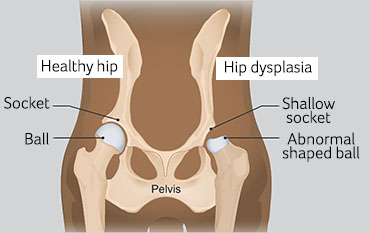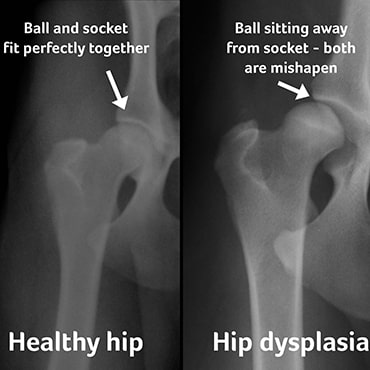Hip dysplasia in dogs
Overview
- Hip dysplasia is a painful condition that causes one or both hip joints to develop abnormally while a puppy is growing.
- Hip dysplasia causes pain, swelling and eventually arthritis.
- Most dogs inherit hip dysplasia from one of their parents and symptoms usually start while they are growing.
- Hip dysplasia most commonly affects medium - large breed pedigree dogs.
- Treating hip dysplasia involves careful exercise, weight control and pain relief. Severely affected dogs may also require surgery.
- Schemes are in place to check for hip dysplasia before mating two dogs. This reduces the number of puppies born with this painful condition.
What is hip dysplasia?
The hips are 'ball and socket' joints, which normally fit together perfectly to enable easy movement. Hip dysplasia is when the hip joints don’t fit together properly and become unstable. Hip dysplasia causes pain, swelling, stiffness and eventually arthritis.
Dogs with hip dysplasia usually begin showing symptoms while they are growing (at around 5-6 months of age). The condition tends to be worse in medium - large breed dogs, fast growing dogs, overweight dogs and dogs who have been over-exercised when young.

Hip dysplasia causes the hip joint to grow into an abnormal shape. Click image to enlarge.
Symptoms
- 'Bunny hopping' - running with both back legs moving together
- Limping/lameness
- Stiffness
- Difficulty getting up and lying down
- Painful hips
- A wobbly or swaying walk
- Difficulty jumping or going up or down stairs
- Less interest in walks
- Skinny hips - a sign of small, weak muscles in the back legs and hips
- Some dogs, with a mild form of the condition, won’t show signs until they are much older and have developed arthritis of the hips.

These x-rays show the difference between a healthy hip and one with hip dysplasia.
Treatment
As a first step, your vet is likely to advise some or all of the treatments below. If your dog responds well, it’s likely your vet will advise continuing care at home without surgery.
Weight control
- Keep your dog's weight in check to ensure no extra strain is put on their joints.
Anti-inflammatory pain relief
- Anti-inflammatory medication (NSAIDs) and/or other pain relief will be prescribed by your vet.
Rest
- Your dog may need periods of rest if their hip dysplasia is causing pain and discomfort.
Controlled exercise
- Unless your vet advises otherwise, regular, short lead walks are ideal.
- It’s important to ensure your dog doesn't over-exercise. Avoid jumping, skidding, chasing, racing around or exercising for long-periods of time.
Surgery
- If your dog has severe hip dysplasia that doesn’t respond to daily management, your vet may suggest surgery.
- There are a few different surgical options - your vet will help you select the most suitable. Most hip dysplasia operations require referral to a specialist veterinary hospital.
Ongoing care
The symptoms of hip dysplasia often continue throughout a dog’s life, meaning they need ongoing care and treatment. Your dog may benefit from some of the additional treatments below:
- Physiotherapy can help build up muscle and take pressure off your dog’s hips.
- Hydrotherapy is a great way to exercise your dog without putting strain on their joints.
- Joint supplements might slow down the development of arthritis.
Outlook
Hip dysplasia is a painful condition that needs lifelong treatment.
Some dogs respond very well to daily management (weight control, exercise control and pain relief), but some do not, and require surgery. If your dog improves with treatment, it’s possible for them to live a long happy life.
Most dogs with hip dysplasia develop arthritis in their hips later in life. Speak to your vet if you think your dog might be developing arthritis.
If your dog’s pain is severe and becomes uncontrollable, it may be necessary to consider making the very difficult decision to put them to sleep.
Prevention and screening
The only way to prevent hip dysplasia is to stop breeding from dogs with the condition. Screening programs are available to check that your dog has healthy hips before mating. If you chose to by a breed prone to hip dysplasia, ask the breeder about hip scores. Always speak to your vet before choosing a new dog or breeding from your dog.
Take a look at PDSA’s PetWise quiz to help make sure you pick the most suitable pet for your lifestyle.
There are lots of lovely, deserving dogs in rescue centres across the UK. You may be able to find your perfect pal in a 'breed specific rescue centre'. Please consider giving a rescue dog a home.
When to contact your vet
Contact your vet if your dog is showing any of the symptoms listed above or you are worried about hip dysplasia.
You know your dog best. If they don’t have the symptoms listed above but you are still concerned it’s always best to contact your vet.
Before you consider breeding from your dog, speak to your vet about screening for hip dysplasia and other inherited diseases.
Breeds at risk
Any breed of dog can develop hip dysplasia but it is much more common in medium to large breed pedigrees including Labradors, German Shepherds, Golden Retriever, Rottweiler, Bernese Mountain Dog, and Newfoundland.
Own a breed at risk of hip dysplasia?
If you own a breed that is at risk of hip dysplasia, you will need to make sure you feed and exercise them correctly, especially while they are growing.
- Exercise. Speak to your vet about how to exercise your puppy as they grow. It’s important to keep them fit, but too much of the wrong type of exercise can make hip dysplasia worse.
- Feeding. It’s important to make sure your puppy is fed an appropriate food for their size, breed and age. They are more likely to have problems later in life if they don't have the correct nutrition as a puppy.

Certain breeds are more likely to get hip dysplasia.
Cost
Treatment for hip dysplasia can mount up to thousands of pounds over a dog’s lifetime. Think about insuring your dog as soon as you get them, before any signs of illness start. This means you will have all the support you need to care for them if they become poorly or develop a condition such as hip dysplasia.
It’s also very important to speak openly to your vet about your finances, the cost of treatment, as well as what you think is right for your dog. There are often several treatment options so if one doesn’t work for you and your pet then your vet may be able to offer another.
Published: June 2019
Did you find this page useful?
Tell us more
Please note, our vets and nurses are unable to respond to questions via this form. If you are concerned about your pet’s health, please contact your vet directly.
Thank you for your feedback
Want to hear more about PDSA and get pet care tips from our vet experts?
Sign up to our e-newsletter
Written by vets and vet nurses. This advice is for UK pets only. Illustrations by Samantha Elmhurst.

